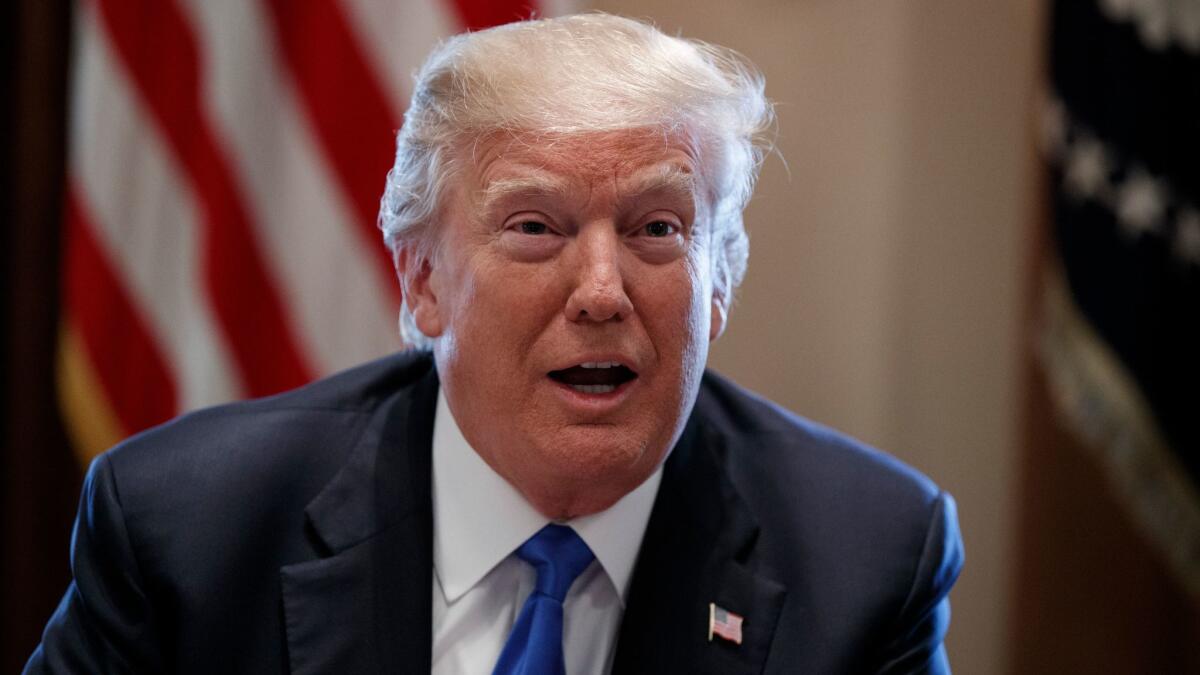Op-Ed: Beyond tweets, here’s how Trump could help the Iranian protesters

- Share via
President Trump has made it clear that the U.S. stands with Iranian protesters, whose demonstrations against the repressive government of Supreme Leader Ayatollah Ali Khamenei were broken up last week but whose demands have yet to be answered. Trump could still aid their cause, and with a relatively easy, risk-free move: He could make public details of the regime’s corruption and help average Iranians understand the full extent of the national wealth that has been transferred from them to their government’s fat cats.
First among the fat cats is Khamenei himself, who personally sits atop a vast economic empire. In second place are the commanders of the Iranian Revolutionary Guard Corps, who run a privileged network of state businesses believed to control up to 40% of Iran’s economy.
The unrest that spiked and spread as the new year began is deeply rooted in economic despair. Inflation is hitting the poor, with the cost of staples, including eggs, increasing by 50% last year alone. Meanwhile, youth unemployment is estimated at roughly 40%.
But there is also a strong political component to Iranian despair. After the 2015 nuclear deal, President Hassan Rouhani promised a new era of prosperity. The deal released more than $100 billion in frozen assets, according to some estimates, and it was supposed to open the country to foreign investment. Average Iranians, however, have seen no change for the better.
Trump could make public details of the Iranian regime’s corruption.
The elite have benefited, and the Revolutionary Guard has flexed its muscles in Iraq, Syria and Yemen, but a stagnant economy, rampant inflation and the collapse of corrupt banking cooperatives have wiped out the savings of low income families. When details of the national budget became known, they sparked outrage. While the regime was offering massive payments to its cronies and increasing funding for foreign adventures, it was planning cuts to social welfare and higher consumer gas prices.
On Dec. 29, Trump quickly tweeted support for the protests, and he has imposed new sanctions on Iran for its pursuit of ballistic missiles. Now he should release information our intelligence agencies have compiled on how much wealth Iranian elites have amassed through their maze of front companies and hidden ownership of Iran’s resources. The Iranian Leadership Asset Transparency Act, passed by the House of Representatives in December, would do just that. The president, however, doesn’t need to wait for an act of Congress to take action. He can immediately declassify information about the financial holdings of those affiliated with the Iranian government.
There is precedent for such an action. The Countering America’s Adversaries Through Sanctions Act, which became law in August, mandates that the secretary of the Treasury report on the holdings and ownership stakes of Russian oligarchs and politically influential, quasi-state entities, such as the natural gas giant Gazprom. We need an analogous report on Iran.
Such documentation, however, takes time. The intelligence community, for fear of compromising sources and methods, is reluctant to release classified information. The president can circumvent some of the difficulty by requiring the CIA to produce a report using methods it has pioneered for collecting information through open sources. Much of the most damning information about Iranian corruption is openly available; it is simply not widely known.
In 2013, Reuters published a lengthy investigation into Khamenei’s holdings. It revealed that through Setad, a conglomerate formed, in part, from “the systematic seizure of thousands of properties belonging to ordinary Iranians,” he controls at least $95 billion in assets. The money is used to consolidate his power and to support terrorist groups abroad — an estimated $700 million to $800 million goes to Hezbollah annually.
If Reuters can provide a glimpse behind the veil of piety that shields the supreme leader’s corruption from his people’s gaze, think how much more would be revealed if the United States government’s knowledge was made available.
We must not underestimate the power of exposing hypocrisy and corruption. The Islamic Revolution in 1979 won popular support in part because of the contrast between the modest, pious and purportedly ascetic life of the revolution’s founder, Ayatollah Ruhollah Khomeini, and the extravagant tastes of the shah of Iran, Mohammed Reza Pahlavi, and his retinue. Much the same popular outrage that mobilized poor Iranians against the monarchy is today chipping away at the legitimacy of the Islamic Republic. In some of the most telling videos from the demonstrations, protesters offer apologies to the late shah for sending him into exile. They did not realize the Islamic Republic would impoverish rather than improve living standards of ordinary Iranians like themselves.
Iran’s citizens — especially the millennial generation — are demanding economic opportunity and basic human rights. Supporting them need not risk American lives or cost the U.S. vast sums of money. The Iranian people’s primary enemies, the supreme leader and the Revolutionary Guard, are America’s enemies, too. By helping them, the United States will help itself. Our strategic interests and our principles fit hand in glove.
Kenneth R. Weinstein is president and chief executive of the Hudson Institute, a policy research organization based in Washington.
Follow the Opinion section on Twitter @latimesopinion and Facebook
More to Read
A cure for the common opinion
Get thought-provoking perspectives with our weekly newsletter.
You may occasionally receive promotional content from the Los Angeles Times.






